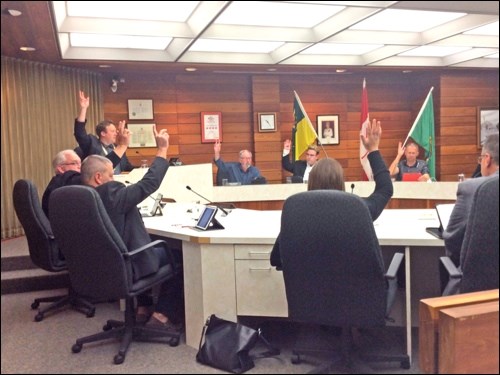The long process to approve the mill rates and set the taxes for 2017 has finally ended at North Battleford city council.
Council gave final approval to several bylaws at Monday’s meeting. Bylaws establishing mill rate factors; levying the tax rate, establishing minimum and base taxes and authorizing the BID levy, and to authorize the UPAR levy all passed third and final reading Monday night.
The mill rate bylaw passed by a 6-1 vote. Councillor Kelli Hawtin was the only “no” vote; she had previously voiced her concerns that not enough information had been given about the alternatives to raising taxes. The other two bylaws carried unanimously.
The mill rate factors bylaw includes both general mill rate factors as well as an additional “provincial downloading mill rate factor” to addressing a city shortfall after the provincial budget in March.
The biggest news of the meeting was that second and third reading carried unanimously for a bylaw authorizing the “levying of a tax rate.” This was the bylaw dealing with the much-talked-about increased mill rate on vacant commercial buildings in North Battleford.
That bylaw applies a mill rate set at two times the annual mill rate for the commercial class to vacant commercial buildings in the “key commercial corridor” along 100th Street/Railway Avenue and also downtown. The properties subject to this mill rate are defined as those that have not maintained a business license, or those that have not activated a water hookup utility account.
A total of 25 properties are impacted by the change. According to a memo from Director of Finance David Gillan circulated at council, in 2017 these will be re-classed in the tax roll and billed with the higher commercial mill rate. A cover letter is also being sent explaining the reason for their reclassification in the tax roll.
As well, all properties with a service connection will begin paying flat utility charges including UPAR charges. And all properties identified as having a service connection but not being reclassified under the Vacant Commercial Buildings - Key Corridor Subclass will get a letter stating the utility and UPAR flat fees are to be paid beginning July 1.
The changes are designed to bring those vacant commercial buildings back into circulation in the city. Earlier at the meeting, administration also shared details about an “aggressive” downtown incentive policy which includes a number of incentives and tax abatements aimed at improving facades, building improvements, residential development, for bringing vacant buildings up to standard, and cleaning up and developing “brownfields,” or contaminated land.
That downtown incentive plan was developed to go alongside the increased vacant buildings mill rate.
With respect to the vacant buildings bylaw, there was a minor change made to the bylaw at the meeting: an amendment was carried that changed the wording of the bylaw, replacing the word “vacant commercial property” with “vacant commercial property with improvements,” so that the bylaw will not apply to completely vacant lots.
There was also discussion as to why the vacant buildings bylaw provisions were restricted to the “key commercial corridor” and not other parts of the city where there are also vacant buildings.
City Manager Jim Puffalt explained the issue was the capacity of the finance department to be able to handle more this year.
He said the focus this year would be “the main trouble areas,” but was open to considering expansion to other parts of the city in the future.
Gillan nevertheless indicated that the bylaw already has wide scope. The 25 vacant commercial buildings in the city covered by the bylaw made up 60 percent of the vacant buildings identified in the city.
“It is not a minority,” said Gillan. “It is a majority already.”
One additional bylaw was also introduced and passed in three readings at Monday’s meeting, to amend the waterworks system bylaw.
According to the memo from Gillan, the wording of this bylaw further clarifies that all properties with a service connection shall pay all flat charges, as per Schedule B of the waterworks bylaw.
With these bylaws out of the way, that clears the way for the property tax notices to finally be sent in the mail.
There was one more bylaw that was before council Monday night and it dealt with the closure of a walkway in the King Street Station area. Second and third reading for that bylaw passed unanimously.




